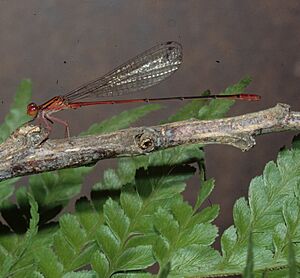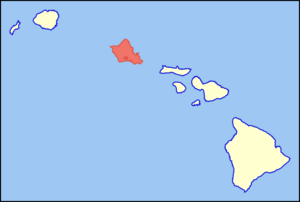Megalagrion leptodemas facts for kids
Quick facts for kids Megalagrion leptodemas |
|
|---|---|
 |
|
| Conservation status | |
| Scientific classification | |
 |
|
| The island of Oahu |
The Crimson Hawaiian damselfly (scientific name: Megalagrion leptodemas) is a very rare and endangered insect. It lives only on the island of Oahu in Hawaii, meaning it is endemic to that place. This special damselfly is listed as endangered by the ESA and critically endangered on the IUCN Red List. This means it's in great danger of disappearing forever.
Crimson Hawaiian damselflies are similar to other narrow-winged damselflies. They used to live in the Ko’olau and Wai'anae mountains. Now, you can only find them in four stream areas in the Ko’olau Mountains. Their biggest problems are losing their homes and dealing with new animals that don't belong in Hawaii. Because they have very few places to live and their groups are small, their future is uncertain. To help them, people need to protect their homes and control the invasive species that threaten them.
Contents
What Does the Crimson Hawaiian Damselfly Look Like?
The Crimson Hawaiian damselfly is one of the smaller damselflies. It grows to about 38 millimeters (about 1.5 inches) long. Its wings can spread to about 40 millimeters (about 1.6 inches).
Male damselflies are bright red. They have black marks on the top of their body segments, from five to seven. Female damselflies are also red, but they have some pale green or gray marks. Their upper body is covered in black.
Baby Crimson Hawaiian damselflies, called naiads, look like other damselfly larvae. They have big eyes, thin legs, and three leaf-like gills at their tail end.
Life Cycle of the Damselfly
Scientists don't know a lot about the full life cycle of the Crimson Hawaiian damselfly because it's so rare. However, they can guess a lot by studying other Hawaiian damselflies.
Megalagrion leptodemas likes to lay its eggs in slow-moving streams and small pools. When they mate, the male damselfly holds the female behind her head. This helps him guard her from other males. To lay her eggs, the female damselfly looks for safe spots in the stream, like plants on rocks under the water.
After the eggs are laid, both adult damselflies stay close to the breeding pools. The male damselflies become very protective of these areas.
In many damselfly species, the eggs hatch in about ten days. Most Hawaiian damselfly naiads live in the water. They breathe using gills on their bodies. They eat small invertebrates and tiny fish. Naiads often rest on rocks or plants underwater. They also swim in the open water of their pool or stream.
After about 4 months of growing, the naiads leave the water. They climb onto rocks or plants and molt (shed their skin) to become adult damselflies. Even as adults, damselflies usually stay close to where they grew up. Adult Hawaiian damselflies become ready to mate in about 16 to 20 days.
Where Do They Live and What Do They Eat?
What Do They Eat?
Young damselflies (naiads) eat small fish, mosquito larvae, and other tiny water creatures. They hide and wait for their prey to come close. Then, they quickly shoot out their jaws to catch it.
Adult narrow-winged damselflies are also hunters. They eat small flying insects like flies, moths, mosquitoes, and midges.
How Do They Behave?
The behavior of Megalagrion leptodemas is much like other narrow-winged damselflies. During mating, males will guard the female from other damselflies. They do this by holding the female behind her head and flying together.
Adult Crimson Hawaiian damselflies stay near the pools where they breed. They often sit on plants next to the stream and protect that area. Most male damselflies are territorial, meaning they guard the spots where females have laid eggs.
Where Is Their Home?
Crimson Hawaiian damselflies live in the slow parts of streams or in pools. They prefer wet lowland areas and wet cliff environments on Oahu. These damselflies live in parts of streams that don't have foreign fish that might eat them. These safe spots are usually above man-made barriers.
Most young damselflies are aquatic. They live in slow-flowing pools and streams, as well as in the plants around them. They stay there until they leave the water to molt into adults. Currently, scientists believe Megalagrion leptodemas lives in only three areas on Oahu, all in the Ko'olau Range.
Where Are They Found Now?
Not much is known about how many Crimson Hawaiian damselflies there are or where exactly they live. Local scientists think this species is the rarest and most endangered damselfly on Oahu.
There are only three known places where the Crimson Hawaiian damselfly has been seen. All of these are in the Ko'olau Mountains. They are found in the lowland wet and wet cliff ecosystems at Moanalua, north Halawa, and Ma'akua. You can see a map of their possible range at this link.
Protecting the Crimson Hawaiian Damselfly
How Many Are Left?
The Crimson Hawaiian damselfly was last seen in the late 1990s. So, there aren't exact numbers of how many are left. However, it's likely that fewer than 1,000 individuals remain. Past studies show that their numbers have dropped a lot. In some places, there were only 10 males or fewer for every 100 meters of stream edge.
Past and Present Locations
In the past, the Crimson Hawaiian damselfly was found in eight areas around Oahu. This included the Waiʻanae Mountains and different spots in the Koʻolau Mountains. Between 1990 and 2008, surveys were done, but they didn't find this species in many of its old locations.
Today, there are only three known places where the Crimson Hawaiian damselfly lives. These are all in the Ko’olau Mountains: Moanalua, north Halawa, and Ma’akua.
The species was last seen in the late 1990s in the wet lowland area of Waiawa. In April 2015, during a special science event called a BioBlitz in Moanalua Stream, scientists saw adult damselflies. They also saw eight male damselflies in the stream on the north side of Middle Ridge. However, when they visited the same spot in 2018, no damselflies were found.
What Are the Biggest Dangers?
The main danger to the Crimson Hawaiian damselfly is that its home is being destroyed. Streams are being changed or dried up because their water is used for other things, like wells. This can make parts of streams completely dry. More flooding and landslides also hurt their homes.
Animals that are not native to Hawaii are also a big threat. The young damselflies, which live in pools and slow stream sections, can be eaten by invasive fish. Studies have shown that where non-native bullfrogs are present, these damselflies are often missing. Ants are also a major danger to the Crimson Hawaiian damselfly.
Looking ahead, climate change will also greatly affect the Crimson Hawaiian damselfly. This species cannot handle warmer water or changes in rainfall very well. Also, there will be more storms and hurricanes, which could destroy the few homes they have left.
Listed as Endangered
On May 11, 2004, a request was made to list this damselfly, along with 224 other species, as threatened or endangered. On September 18, 2012, the US Fish and Wildlife Service officially listed the Crimson Hawaiian damselfly as endangered under the Endangered Species Act. It is also listed as critically endangered on the IUCN Red List.
Recovery Plan
The Crimson Hawaiian damselfly is part of a special plan called the US Fish and Wildlife Service’s Recovery Plan for Oahu. This plan, released in July 2018, is now being put into action. It has several important steps:
- Protecting Homes and Stopping Threats: This involves finding all the remaining damselfly groups and their homes. Scientists will also study how climate change might affect them and identify key areas for their recovery. They will work to protect these areas long-term and watch how their efforts are working.
- Controlling Specific Dangers: This means finding ways to control animals like slugs, rodents, non-native fish, and amphibians that harm the damselflies.
- Helping Populations Grow: The plan aims to find new places where damselflies can live or to add more damselflies to existing groups. This includes preparing new sites and releasing damselflies raised in special programs.
- Stopping New Threats: This involves looking for new pests or invasive species before they spread widely. It also means improving border security to prevent new harmful species from entering Hawaii.
- Doing More Research: Scientists need to learn more about how many damselflies there are, how they move, and how long they live. This research helps them make better plans.
- Monitoring Progress: A detailed plan will be put in place to watch the damselflies and their homes.
- Working with Others: The plan encourages working with different groups and people to achieve these goals.
In the short term, the recovery plan tries to reduce dangers like habitat loss and invasive species. It also plans future steps to learn more about the damselfly and improve conservation efforts. In the long run, the plan hopes to lessen the effects of climate change, prevent future threats, and teach the public about this important species.
Images for kids





